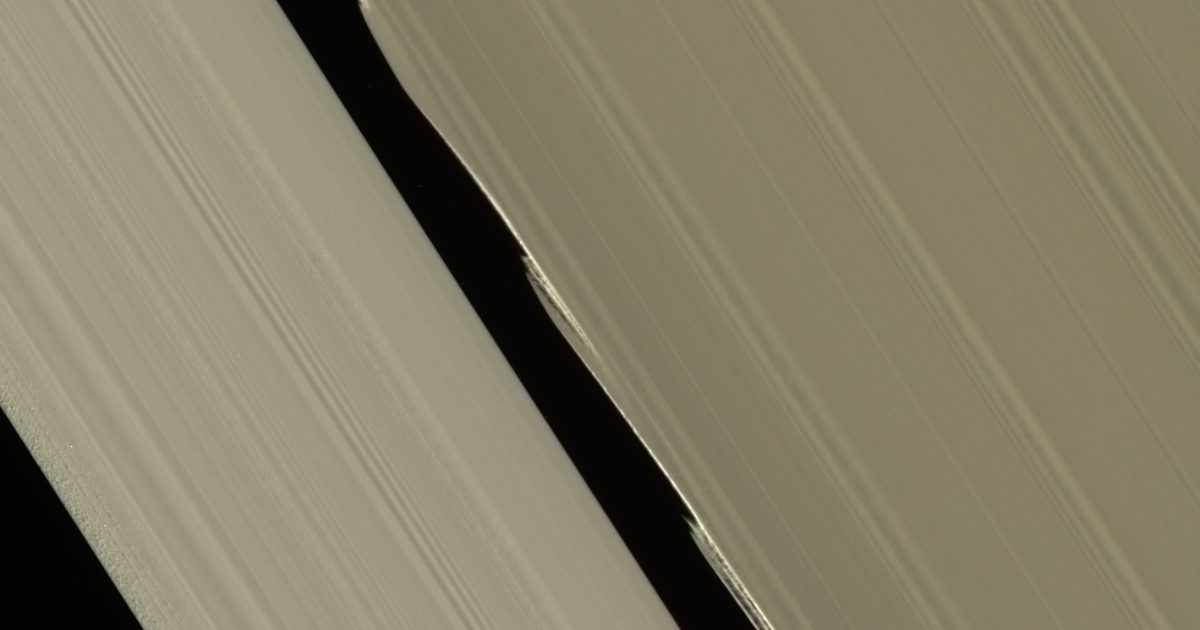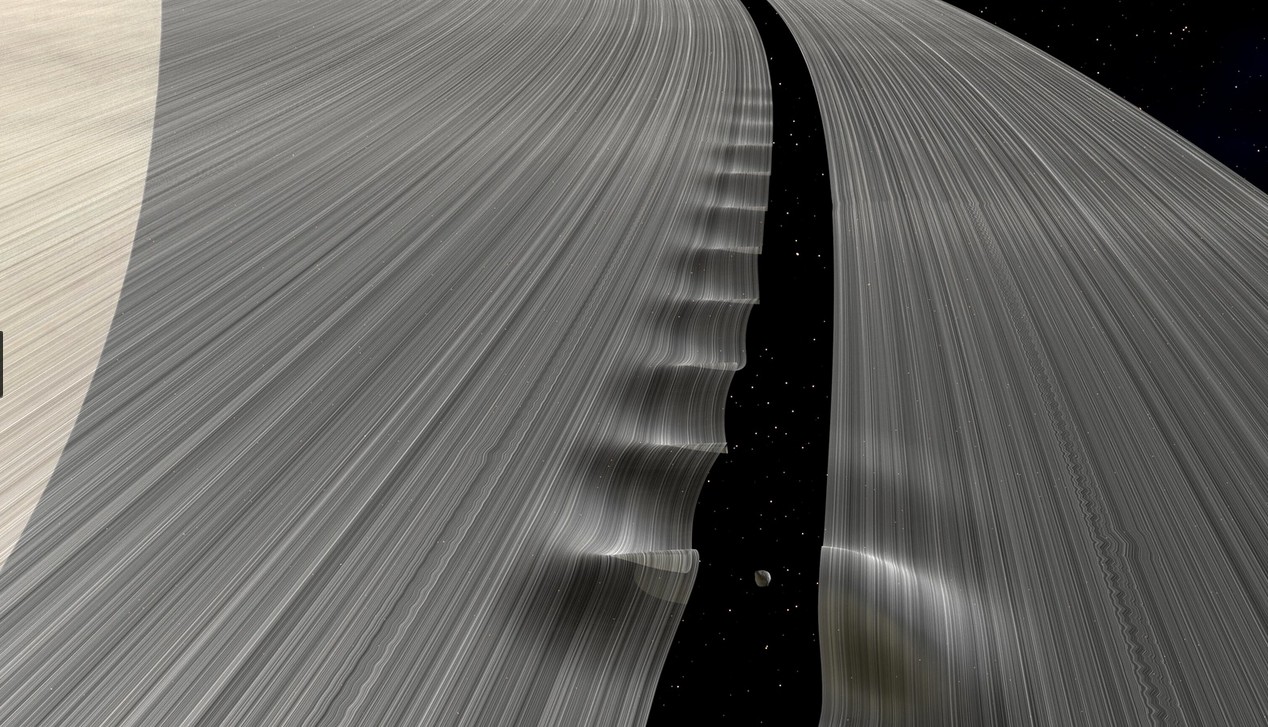Did you see this?
-
Did you see this? It's an artist's conception of how gravity from the tiny moon Daphnis creates ripples in Saturn's rings - created by Kevin Gill of NASA.
This image was pretty popular here, and elsewhere on the web - but people often don't come out and say from the start that it's not a photo. The actual photos are less beautiful but... hey, they're real! And the ripples look different in the photos. Let's take a look.
(1/n)
-
Did you see this? It's an artist's conception of how gravity from the tiny moon Daphnis creates ripples in Saturn's rings - created by Kevin Gill of NASA.
This image was pretty popular here, and elsewhere on the web - but people often don't come out and say from the start that it's not a photo. The actual photos are less beautiful but... hey, they're real! And the ripples look different in the photos. Let's take a look.
(1/n)
This 2005 photo, taken by the Cassini probe, was the first time anyone actually saw Saturn's moon Daphnis! It's only 8 kilometers across.
This gap in Saturn's A ring was first discovered by Voyager, and it was named the Keeler Gap. It's 35 kilometers wide. I guess this gap let people guess the existence of a moon, and later the ripples in the A ring let people guess where the moon must be! I don't really know the history here.
(2/n)
-
This 2005 photo, taken by the Cassini probe, was the first time anyone actually saw Saturn's moon Daphnis! It's only 8 kilometers across.
This gap in Saturn's A ring was first discovered by Voyager, and it was named the Keeler Gap. It's 35 kilometers wide. I guess this gap let people guess the existence of a moon, and later the ripples in the A ring let people guess where the moon must be! I don't really know the history here.
(2/n)
There's a larger gap in the A ring called the Encke cap, created by a larger moon called Pan, which you can see clearly here. To the left you see the smaller Keeling gap. If you look very closely you can see the ripples near the Keeling gap... and if you look *very* closely you can see, or at least imagine, the moon Daphnis.
(3/n)
-
 F myrmepropagandist shared this topic
F myrmepropagandist shared this topic
-
Did you see this? It's an artist's conception of how gravity from the tiny moon Daphnis creates ripples in Saturn's rings - created by Kevin Gill of NASA.
This image was pretty popular here, and elsewhere on the web - but people often don't come out and say from the start that it's not a photo. The actual photos are less beautiful but... hey, they're real! And the ripples look different in the photos. Let's take a look.
(1/n)
I did see this! But, I didn't know if it was a reconstruction and if it was one how accurate it was so I didn't share it. I thought "I ought to find out if that really happens..." so I'm delighted to see this thread.
-
There's a larger gap in the A ring called the Encke cap, created by a larger moon called Pan, which you can see clearly here. To the left you see the smaller Keeling gap. If you look very closely you can see the ripples near the Keeling gap... and if you look *very* closely you can see, or at least imagine, the moon Daphnis.
(3/n)
Now here is a really *great* actual photo of Daphnis and the ripples it creates in Saturn's rings!
It was taken by the Cassini probe and released in February 2017. It was taken in visible light using Cassini’s narrow-angle camera. Cassini was 28,000 kilometers away from Daphnis, and the image scale is 168 meters per pixel.

Saturn’s moon Daphnis in the Keeler Gap
Daphnis, one of Saturn’s small ring-embedded moons, is seen here kicking up waves as it orbits within a gap between rows of icy ring particles.
(www.esa.int)
What other really good photos can we find?
(4/n)
-
There's a larger gap in the A ring called the Encke cap, created by a larger moon called Pan, which you can see clearly here. To the left you see the smaller Keeling gap. If you look very closely you can see the ripples near the Keeling gap... and if you look *very* closely you can see, or at least imagine, the moon Daphnis.
(3/n)
@johncarlosbaez I was curious if the impression image was from fairly rigorous simulation / other very accurate modelling? Makes me want to find / build a gravity simulator for huge numbers or particles!
-
Now here is a really *great* actual photo of Daphnis and the ripples it creates in Saturn's rings!
It was taken by the Cassini probe and released in February 2017. It was taken in visible light using Cassini’s narrow-angle camera. Cassini was 28,000 kilometers away from Daphnis, and the image scale is 168 meters per pixel.

Saturn’s moon Daphnis in the Keeler Gap
Daphnis, one of Saturn’s small ring-embedded moons, is seen here kicking up waves as it orbits within a gap between rows of icy ring particles.
(www.esa.int)
What other really good photos can we find?
(4/n)
Here's a great photo of Daphnis in the Keeler gap in real color! It was taken by Cassini on July 5, 2010 - taken in red, green, and blue and then recombined.

Daphnis makes waves in the Keeler Gap
Daphnis and waves of ring particles kicked up by gravity, imaged by Cassini in true color on July 5, 2010.

The Planetary Society (www.planetary.org)
(5/n)
-
I did see this! But, I didn't know if it was a reconstruction and if it was one how accurate it was so I didn't share it. I thought "I ought to find out if that really happens..." so I'm delighted to see this thread.
Sometimes cool things really do exist!
-
Here's a great photo of Daphnis in the Keeler gap in real color! It was taken by Cassini on July 5, 2010 - taken in red, green, and blue and then recombined.

Daphnis makes waves in the Keeler Gap
Daphnis and waves of ring particles kicked up by gravity, imaged by Cassini in true color on July 5, 2010.

The Planetary Society (www.planetary.org)
(5/n)
And here's an excellent image of Daphnis taken by the Cassini spacecraft on one of its ring-grazing passes on January 16, 2017 - the closest to Daphnis it's gotten so far, I believe!
NASA says:
"Material on the inner edge of the gap orbits faster than the moon, so the waves there lead the moon in its orbit. Material on the outer edge moves slower than the moon, so waves there trail the moon. The waves Daphnis causes cast shadows on Saturn during its equinox when the sun is in line with the plane of the rings."
(5/n)
-
And here's an excellent image of Daphnis taken by the Cassini spacecraft on one of its ring-grazing passes on January 16, 2017 - the closest to Daphnis it's gotten so far, I believe!
NASA says:
"Material on the inner edge of the gap orbits faster than the moon, so the waves there lead the moon in its orbit. Material on the outer edge moves slower than the moon, so waves there trail the moon. The waves Daphnis causes cast shadows on Saturn during its equinox when the sun is in line with the plane of the rings."
(5/n)
Finally, here's a really crazy picture by Kevin Gill - a view you could only see if you sailed through the Keeler gap!
Someday I hope humanity does this.
You can see more images by Kevin Gill here:
(6/n, n = 6)

